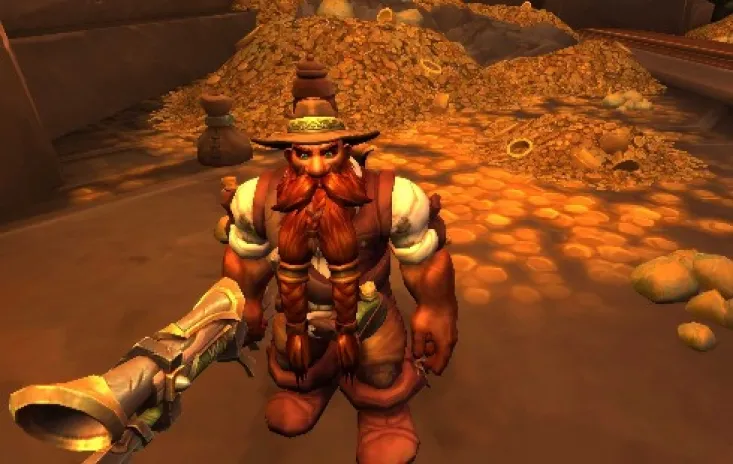
Pantone's Color of the Year an Endless Neutral Loop
Section: Fashion
 In the world of Azeroth, people fight dragons, not inflation. Or so it seems -- until you look at your repair bill, check Auction House prices, or try to buy a flask on raid night. Like it or not, World of Warcraft has a fully functioning economy. And if you have ever wondered why token prices spike, or why that old mount costs more than your car, you are not alone. In fact, some players have stopped wondering altogether. They just buy WoW gold and skip the guessing game. But for the rest of us, let's take a closer look at how the in-game economy works and why Blizzard sometimes feels like a central bank.
In the world of Azeroth, people fight dragons, not inflation. Or so it seems -- until you look at your repair bill, check Auction House prices, or try to buy a flask on raid night. Like it or not, World of Warcraft has a fully functioning economy. And if you have ever wondered why token prices spike, or why that old mount costs more than your car, you are not alone. In fact, some players have stopped wondering altogether. They just buy WoW gold and skip the guessing game. But for the rest of us, let's take a closer look at how the in-game economy works and why Blizzard sometimes feels like a central bank.
Why World of Warcraft Has a Real Economy
You log in. You farm herbs. You sell them on the AH. Someone buys them to craft a potion. That potion gets used in a Mythic raid. Gold moves. Just like in the real world, everything in WoW is connected by a supply chain, and at the core of it all is gold.
The Auction House functions like a simplified stock market. Prices go up and down based on patch cycles, player demand, and the ever-present threat of content droughts. When a new raid opens, materials spike. When a meta shifts, old gear floods the market. And when a new profession gets buffed (hello, Dragonflight inscription), the price of ink suddenly matters.
When Inflation Hits Azeroth
Gold inflation happens when the game introduces more gold than it removes. Think of all the ways players inject money into the system: world quests, vendor trash, raw gold from dungeons, mission tables, treasure maps, you name it. All that adds up. Now, how do players lose gold? Mostly through repairs, auction fees, vendor items, and training. But it's not nearly enough to offset the input. That's how we get inflation -- more gold chasing the same number of goods.
Blizzard occasionally steps in with gold sinks to try to stabilize things. The most famous example? Mighty Caravan Brutosaur, aka the Longboi. A mobile auction house that cost 5 million gold back in BFA. It was intentionally overpriced to suck gold out of circulation. And when it got removed from vendors in Shadowlands, its market value skyrocketed. Today, it's the Bitcoin of WoW mounts. Everyone wants one, and no one wants to talk about how much it actually costs.
What Drives Inflation
Contrary to popular belief, it's not just bots or Gallywix-type boosters hoarding gold. A lot of inflation comes from completely normal players just doing daily content. Shadowlands mission tables, for example, printed gold for months. Dragonflight toned it down a bit, but the base systems still give out a lot of currency for minimal effort.
Then you have crafting orders. Cross-realm trading limitations create local mini-markets where people can charge ridiculous markups. In some realms, a single piece of gear can cost 30k more than in others. Multi-accounts (multiboxers) create a sense of the artificial shortage of some types of mats by farming all the time. Imminently supply sinks such as costly recipes, advanced upgrades, and profession tools are attempted by Blizzard to keep in balance, but it is always a game of catch-up.
Token Price Spikes: It's Not Just the Expansion Hype
Token fluctuations aren't always tied to game content. Sometimes, real-world events play a role. During the early 2020 lockdowns, WoW token prices went wild. More people were playing, fewer were working, and suddenly demand exploded. On EU servers, prices jumped by 40% in a few weeks.
Same story during economic uncertainty: in regions where the average monthly salary barely crosses $500, WoW tokens start to look like a strangely reliable way to "make it work."Why buy a $15 sub if you can farm gold and pay in-game? And when gold is cheap (post-patch farm boom), more people stockpile. This isn't just casual speculation. It's behavioral economics in action, filtered through a fantasy MMO.
Is It Worth Playing the Market?
That depends. Some players love it -- flipping glyphs, speculating on mats, or timing token purchases like seasoned investors. Others just want enough gold to repair gear and buy a few enchants.
If you're in the latter group, it's often simpler to buy WoW gold and skip the daily AH hustle. But even if you don't play the market, it still affects you. Every potion, every enchant, every BOE on the AH comes with a price tag driven by economic forces. A little knowledge of how it all works can give you the advantage- at least it will prevent you from paying over the odds.
Azeroth Is More Capitalist Than You Think
Behind the dragons and dungeons, WoW is quietly teaching us economics. It has inflation, speculation, supply shocks, asset bubbles, and artificial scarcity. It rewards productivity, punishes hoarding (eventually), and creates social tension over wealth gaps (looking at you, Brutosaur gang).
The further you spot that, the more you realize: WoW gold is not only a sum that is resting in your sacks. It's a reflection of what people want, how they play, and what they're willing to pay for. And in Azeroth, as in life, the ones with the most gold tend to pull the lever.

Section: Fashion

Section: News

Section: Business

Section: Fashion

Section: Business

Section: Arts

Section: Politics

Section: Health Insurance

Section: News

Section: News
Both private Health Insurance in Germany and public insurance, is often complicated to navigate, not to mention expensive. As an expat, you are required to navigate this landscape within weeks of arriving, so check our FAQ on PKV. For our guide on resources and access to agents who can give you a competitive quote, try our PKV Cost comparison tool.
Germany is famous for its medical expertise and extensive number of hospitals and clinics. See this comprehensive directory of hospitals and clinics across the country, complete with links to their websites, addresses, contact info, and specializations/services.
Join us for an enchanting Christmas adventure at the Münchner Marionettentheater! Experience the marionette play 'Der verschwundene Wunschzettel' by Siegfried Böhmke, featuring our beloved Kasperl Larifari and his little friend Stupsi. As Christmas approaches, both Kasperl and Stupsi have prepared...



No comments yet. Be the first to comment!